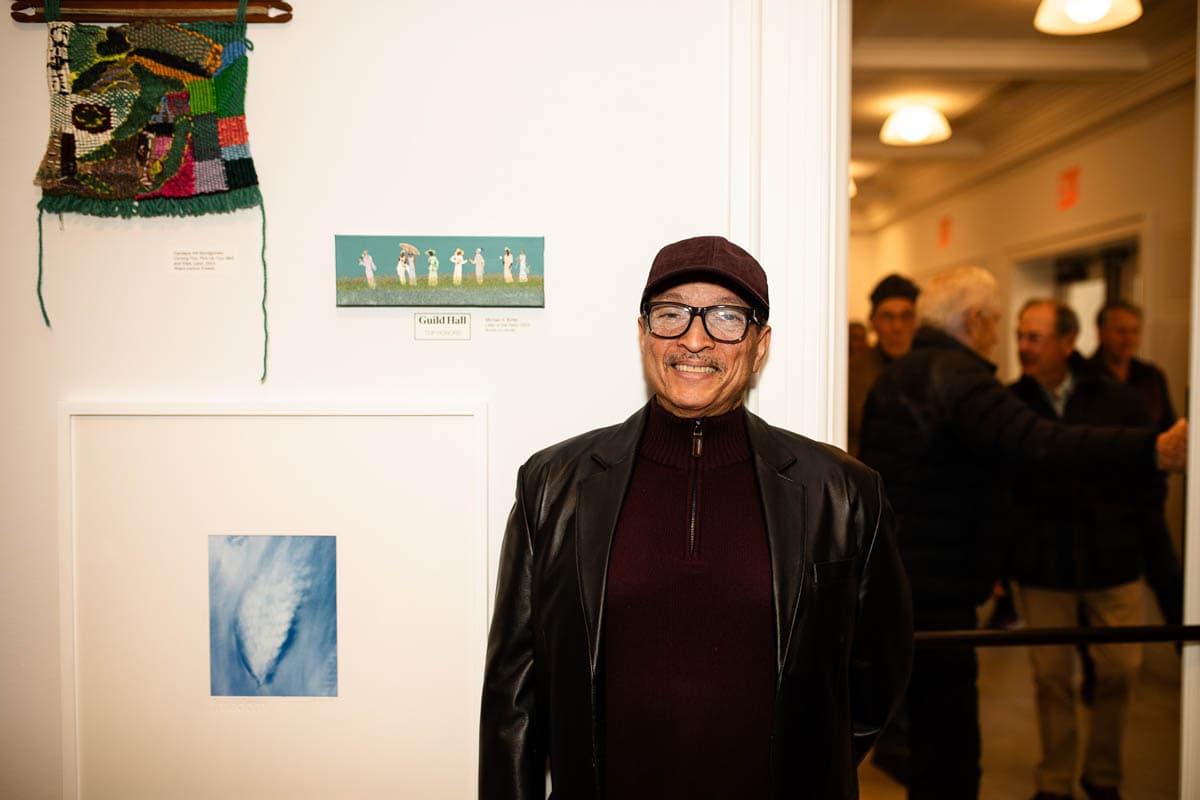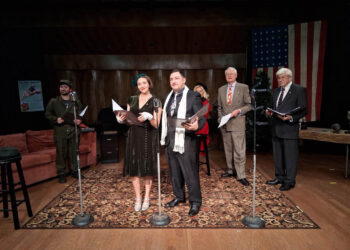
Earlier this month, Guild Hall invited the community to slow down and look closer during Art & Social: Painting Tiny with Michael A. Butler. This hands-on workshop led by East End artist Michael A. Butler explored the art of working on a miniature scale—inviting participants to create their own small-format paintings using magnifying tools and a steady hand.
A Sag Harbor native whose work blends history, spirituality, and local storytelling, Michael has been celebrated for his intricate and thoughtful pieces. He received Top Honors at Guild Hall last year and Honorable Mention the year before.
In this intimate workshop, he shared how shifting perspective—literally and creatively—can transform the way we see art, space, and detail. Michael spoke more about his inspiration, his connection to the East End, and what he hopes participants took away from painting on the tiniest of canvases.
Can you tell us a bit about your background?
MB: Much of my non-artistic professional career has been in the field of human services. I have a master’s degree in public administration and have worked with such diverse populations as the unhoused, senior citizens, youth, and the developmentally disabled. More recently I was manager of the Sag Harbor Whaling and Historical Museum.
Throughout most of that period, I was always doing something creative, either sketching, drawing, or painting when time and energy allowed.
What first drew you to working on a small scale?
MB: For a number of years, I settled upon pastels as my medium of choice. From there, I experimented with oil paint but found the drying time too long. Once I had moved on from working in pastel I just seemed to gravitate towards smaller canvases. Typically in the 8” x 10” or 9” x 12” range. While pastels provided me with a freer range of movement and a larger surface area, I could not obtain a desired precision of subject matter. Over time, I gravitated towards smaller and smaller canvases using acrylics as my medium. Currently I have a body of work in the scale of 2” x 2” and 3” x 3”. The latter dimensions are the canvas size we used in the workshop.
The event invited participants to bring a magnifying glass for detail work as they worked off the “teeniest, tiniest canvas”. Can you explain why you chose small scale for this workshop and how it changes the creative process and what challenges or joys it brings?
MB: It was actually Amy Kirwin of Guild Hall who suggested that I conduct a workshop on tiny painting at Guild Hall. I realize that it’s a challenge for most of the participants, but I also think that they were fascinated by the challenge. One needs a steady hand to work on such a small scale. One’s sense of perspective also changes. Use of a magnifying glass helps tremendously but adds another difficult component as there is a balancing act among the canvas, the brush, and the magnifier—unless one has a visor with the magnifier included or uses a free-standing one, but these present their own set of challenges.
What do you hope participants experienced or took away from this session, beyond simply creating a small painting?
MB: Hopefully participants left with an appreciation of the challenges involved and a realization that there is indeed a place in the art world for small-sized paintings and that they can have as much impact as larger creations. With wall space sometimes limited in many homes there is a niche market for this type of art.
Being on the East End and working with Guild Hall situates your art in a region known for its creative culture. How does the Hamptons environment influence your practice?
MB: The East End provides me with limitless sources of inspiration. There is so much natural beauty surrounding us. Water, whether ocean, bay, or creek are frequent elements incorporated in my paintings.
But not just the physical environment influences my themes. There is so much history here! My works have always referenced the unseen, the unknown with inspiration drawn from dreams, religious iconography, mythology…
Now, more recently, I depict the unseen, unknown, hidden stories that lie just beneath the surface of the visible, built environment here on the East End. Specifically, I attempt to depict the lesser-known stories of the formerly enslaved, the Indigenous, the un-represented of whom there is little or no documentation in existence. I strive to give life to their experiences as they, too, are an integral part of local history.
This region is home to me. I grew up summering in Sag Harbor as my family started summering here over one hundred years ago and thus my roots run deep.
Among many, the arts community has been extremely supportive of my artistic work. There are so many creatives here! We encourage, support and, yes, at times, feed off each others’ energies. I am not sure that I would have able to thrive so well as an artist were I situated elsewhere.
Many workshop participants may not identify as “artists” or have formal training. How did you approach making the event accessible and enjoyable for all skill levels?
MB: I find that many people who are not formally trained or who do not identify as an artist are often reticent or intimidated by the artistic process. They may even be embarrassed to display their finished product. True, some others approach the process with glee, and I always encourage everyone to follow their own natural creative instincts.
We all possess different talents whether it be gardening, cooking, decorating, carpentry, etc. To those who say, “I can’t even draw a straight line,” I respond that perhaps the line is not meant to be straight.
There are infinite sources of inspiration, and one just has to make use of the communicative process among mind, hand, and eye.
You’ve achieved recognition at Guild Hall, which is a strong regional milestone. What does exhibiting and now teaching in this region mean to you?
MB: Receiving such recognition (Top Honors last year, Honorable Mention the year before) from Guild Hall, one of the region’s prestigious cultural institutions, is a great honor and provides validation to my work.
I don’t consider myself so much of a teacher as a co-participant in the creative process. I enjoy sharing as I impart my knowledge, skills, and love of art with those who appreciate my works.
What’s next for your own art practice—any new directions, ideas or projects that you’re excited about exploring?
MB: As more local histories are uncovered I look forward to bringing those images to life.
Additionally, after having recently toured a couple of mansions in upstate New York that also relied upon the labor of the enslaved, I have broadened the scope of my story lines… a different locale with a varied set of mental and geographical obstacles.
I have also received several opportunities to either illustrate a children’s book or to design a book cover. I am looking forward to seeing those through to completion.
To learn more about Michael A. Butler and his recognition at Guild Hall, click here.











